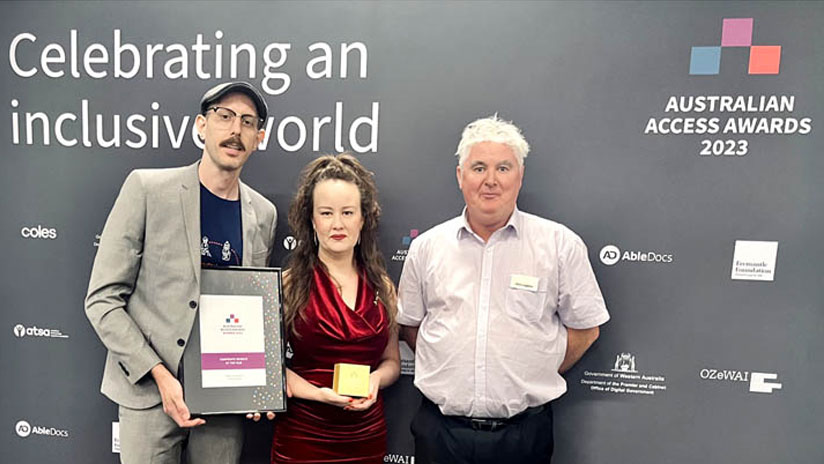Big waves, low EME
In April, we tested our mobile network at Bells Beach on the Great Ocean Road in Victoria, ahead of Easter's famous surfing competition - Rip Curl Pro Bells Beach.
Footage: A man wearing a blue Telstra-branded cap and hi vis gear stands on a balcony with a beautiful sea view behind him. He is holding a testing instument and speaking directly to camera. We then cut to footage of surfers practicing their runs.
Mike speaks directly to camera: Hi, it's Mike Wood from Telstra. Now, we're down at Bell's Beach for the Rip Curl Surf Pro Classic. I mean, what an iconic location to come and do some network tests.
Have a look at the waves behind us here, they have been really pumping. I mean, we've got some of the best international surfers out doing their practice runs. Qualifying is on Tuesday but we've seen some awesome names here.
Footage: A split screen of Mike talking to camera and an image showing the top of the base station. We then cut to a close-up of the EME testing equipment as Mike points out the graphs and explains them to us.
Mike speaks directly to camera: We've just installed the cow the cell on wheels. I'm not sure if you can see it - it's over my shoulder. You can probably see it just up above the Rip Curl tent. You'll be able to see the uh, top of the base station, but come and have a look at the spectrum that we've got.
What we've got now is 700, 850. We've got 1,800 2,100 2,600 the middle part is Wi-Fi from the uh, Rip Curl tent and new 5G frequencies at the very top. So this is 3,600 and 3,700 MHz, all providing us with fantastic connectivity.
Now some people often ask us "What's the EME like at a special event when we've got so many people here and they're all using the network?" Well that's what we're doing today we're testing what the levels are like and if you come in, I'll show you a total of .517%, so that's well over one hundred times below the public safety limit. The safety limit is 100% and that's the very top line. You can see the 100 line, so if you just have a look here, the 100 line is the public safety limit and we're measuring 0.5.
So that's very very low and we've loaded the network with all of our graduates activating the network and doing speed test so you know I reckon this has to be one of the best places I've ever done a network test.
And think that's a wrap from Bell's Beach!
End frame: Telstra logo.
Definitions
Terminology to help you better understand this video and article:
- COW (Cell on Wheels): a portable base station that's used for special events and during natural disasters to provide mobile coverage.
- EME: the electromagnetic energy from our wireless communications.
- Gigahertz (GHz): a measurement of frequency that's used to measure electro magnetic frequencies.
Testing EME levels at Bells Beach
How do they stack up during special events with temporary coverage?
The surf's up with massive waves, pro surfers and fantastic weather. To ensure great coverage for the thousands of spectators and officials, we've installed a Cell on Wheels or more commonly called a COW! Bells Beach is just west of Torquay on the Great Ocean Road and receives mobile coverage from the nearby towns, but not enough to cater for an international surfing event.
Expertly tested by our 2025 grads
To measure the EME levels, we needed to load the network. So, we unleashed our brilliant new 2025 graduates with free 5G and data to truly surf the network. As expected, they didn't disappoint, clocking impressive speeds and generating extreme loads.
We found EME levels at 100X below the public safety limit
The maximum EME levels varied from as low as 0.01% down on the beach to less than 10% very close to the Cell on Wheels (COW), maintaining very low levels even under extreme loads. In the main viewing areas up on the cliffs where many spectators were, the EME levels were at 0.5%, over 100 times below the public safety limit, even under extreme load.
During special events like this, we find the average EME levels to be lower than the extreme tests we conducted – in fact, at Bells Beach, the average EME levels were approximately 10 times lower than the maximum under extreme load. As with all our mobile network designs, we ensure that safety assessments are conducted from design to installation.
How we tested the EME
To get the most accurate results, we follow the base station test methods in the International Electrotechnical Commission (IEC) standards, and for the Bells Beach testing, we used the Narda Selective Radiation Meter and new Signal Shark test equipment. These both ensure we can identify all the different mobile signals for the EME analysis.
A special shout-out to our 2025 Telstra graduates who volunteered their time to learn all about Telstra’s COWs and assist with the testing. We appreciate their efforts.
Explore more on these topics

Doing better by the environment
Reducing emissions, investing in renewable energy and collaborating to drive positive environmental action means we can all help make a difference. Let's do this.
Explore sustainability at Telstra

